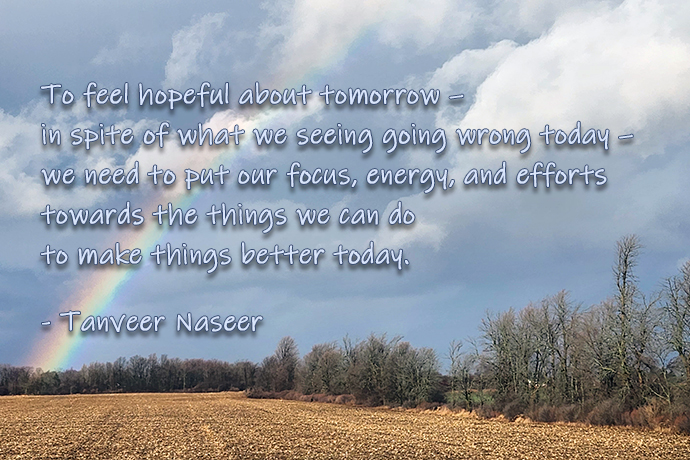“We come to the climate movement thinking not what we’re upset about and what we’re angry about, but what gives us hope for changing the world. That is what I want to bring to this space.” – Xiye Bastida
These days, it can seem challenging to feel any sense of hope for the future. Between devastating conflicts, societal divisiveness, economic uncertainty, an on-going housing crisis, numerous failures in political leadership, not to mention the growing challenge of addressing climate change, it’s easy to ask ourselves –
‘What is there to be hopeful about?’
But in a recent piece for Korn Ferry, Daniel Goleman writes:
“Hope is a vital part of motivation. Hope is what drives leaders and teams to commit to things like sustainability or equity and inclusion.”
But how can we be more hopeful in the onslaught of so much negativity about what’s going wrong around us and around the world?
Goleman shares a simple, but powerful step we can all take to begin that process.
“Hopeful people set meaningful goals they believe they can accomplish and identify ways to achieve them.”
In other words, hope doesn’t require us to focus solely on the positive while ignoring the negative things going on around us.
Instead, in order for us to feel hopeful about tomorrow – in spite of what we seeing going wrong today – we need to put our focus, energy, and efforts towards the things we can do to make things better today.
So what can you do to turn the tide of negativity around and affect real change? It doesn’t have to be ground-breaking or tangible at first.
But it may very well create a ripple upon which others will contribute their efforts, their energy, their talents and creativity towards affecting an enduring and sustainable change, one that might even help you play a part in being that “change you wish to see in the world”.
I often tell the leaders I work with, and in my keynotes and workshops, that leadership is not easy and it’s not meant to be. After all, the job of a leader is to bring out the best in those around them.
And at times like these, a key element you as a leader need to instill and inspire in those you lead is hope. Hope that we can not only make it through these challenging times, but that we will make things better for everyone.
That’s what the most successful leaders share in common – a vision of a better future that people want to commit themselves to making a reality because it’s not just about the gains a leader will attain through those collective efforts.
Instead, their vision is about what all of us stand to gain by pooling our collective efforts around this common, meaningful goal that defines why we do what we do.
To share another quote from Goleman’s piece:
“In a time of great suffering, hope can feel hard to muster. And yet, it’s imperative.”
That’s an imperative that doesn’t simply lie on the shoulders of those in positions of leadership or power.
Rather, it’s an imperative each and every one of us should take on, not just for the benefit of those around us, but also for ourselves if we truly want to feel like what we do – and what we can offer – matters and can make a difference beyond ourselves.


Tanveer Naseer’s discussion of the significance of hope in leadership resonates well with my personal experiences. I once confronted a difficult project in which retaining optimism was critical. By being optimistic and fostering optimism in my team, we overcame challenges and achieved achievement. Echelon Front’s suggested reading list contains works about leadership and hope, which provide significant insights for leaders seeking to inspire and encourage their people.